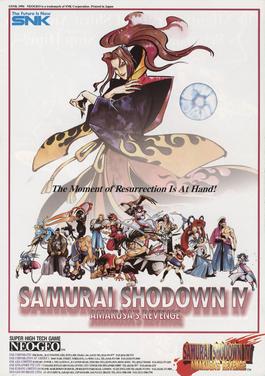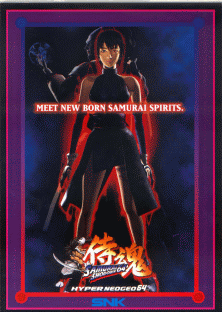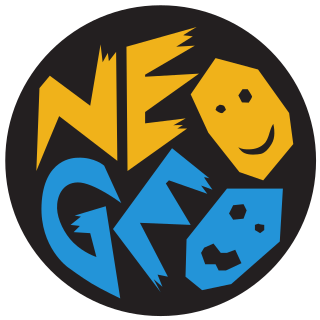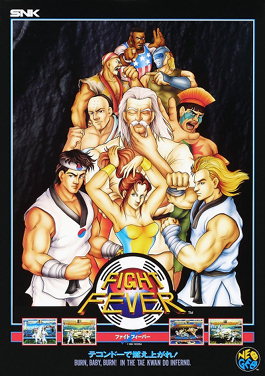
The Neo Geo Pocket (NGP) is a monochrome handheld game console released by SNK. It was the company's first handheld system and is part of the Neo Geo family. It debuted in Japan in late 1998 and was primarily sold in Japan and Hong Kong. The system and all five English games saw limited distribution in the west, where it could be ordered directly from SNK USA.

The Neo Geo, stylized as NEO•GEO and also written as NEOGEO, is a ROM cartridge-based arcade system board and fourth-generation home video game console released on April 26, 1990, by Japanese game company SNK Corporation. It was the first system in SNK's Neo Geo family.

The Neo Geo CD is the second home video game console of SNK Corporation's Neo Geo family, released on September 9, 1994, four years after its cartridge-based equivalent. This is the same platform, converted to the cheaper CD format retailing at $49 to 79 per title, compared to the $300 cartridges. The system was originally priced at US$399, or £399. The system can also play Audio CDs. All three versions of the system have no region lock, but they are region aware, and some games will display English or Japanese depending on the console's region setting. The Neo Geo CD was launched with a bundled control pad instead of a joystick like the AES version. A newly designed joystick was released alongside the Neo Geo CD, and the system was compatible with controllers from the AES.

SNK Corporation is a Japanese video game hardware and software company. It is the successor to the company Shin Nihon Kikaku and presently owns the SNK video game brand and the Neo Geo video game platform, and electronics. SNK's predecessor Shin Nihon Kikaku Corporation was founded in 1978 by Eikichi Kawasaki. In 1981, the name was informally shortened to SNK Corporation, which became the company's official name in 1986.

The Neo Geo Pocket Color (NGPC) is a 16-bit color handheld game console developed and manufactured by SNK. It is a successor to SNK's monochrome Neo Geo Pocket handheld which was released in 1998 in Japan, with the Color being fully backward compatible. The Neo Geo Pocket Color was released on March 19, 1999 in Japan, August 6, 1999 in North America, and October 1, 1999 in Europe, entering markets all dominated by Nintendo, competing with Nintendo's Game Boy Color.

The Atomiswave is a custom arcade system board and cabinet from Sammy Corporation. It is based on Sega's Dreamcast console, Sega sharing similarities with the NAOMI, as far as it uses interchangeable game cartridges, as well as a removable module for changing the control scheme, but unlike the NAOMI, the Atomiswave does not feature expanded RAM compared to the Dreamcast.

Samurai Shodown IV: Amakusa's Revenge is the fourth in SNK's flagship Samurai Shodown series of fighting games. Chronologically, it is the second and final chapter of a story between Samurai Shodown and Samurai Shodown II, with Samurai Shodown III being the first chapter. Samurai Shodown! on the Neo Geo Pocket is a monochrome adaptation of this game, and it was followed by Samurai Shodown! 2 on the Neo Geo Pocket Color, which is a 2D adaptation of Samurai Shodown 64: Warriors Rage.

Samurai Shodown 64: Warriors Rage, known as Samurai Spirits 2: Asura Zanmaden in Japan, is a 3D fighting game produced by SNK for its Hyper Neo Geo 64 system. It is the follow-up to the original Samurai Shodown 64 on the same platform. A PlayStation game was released as part of the same series; despite using the Warriors Rage subtitle in America, it is a different game than 64: Warriors Rage. Samurai Shodown! 2 on the Neo Geo Pocket Color is a 2D adaptation of this game, and a sequel to Samurai Shodown! on the Neo Geo Pocket which was a monochrome adaptation of Samurai Shodown IV.

Samurai Shodown 64, known as Samurai Spirits in Japan, is a 3D fighting game produced by SNK for its Hyper Neo-Geo 64 system. It was SNK's first 3D fighting game. After having released four Samurai Shodown games on the Neo-Geo, SNK announced that they would be producing a new arcade hardware platform, this one 64-bit and with extensive 3D capabilities. Although it was never ported to home consoles, it was followed by a second 3D installment titled Samurai Shodown 64: Warriors Rage.

Samurai Shodown II, known in Japan as Shin Samurai Spirits: Haōmaru Jigokuhen, is a 1994 fighting game released as the second entry in SNK's Samurai Shodown series. Like the original Samurai Shodown, the sequel was initially released for the Neo Geo arcade and home system.

Fatal Fury: Wild Ambition is a 3D fighting video game produced by SNK and is a spin-off of the Fatal Fury series of fighting games. The game was released in Japanese arcades on January 28, 1999. It was one of the last games released for the Hyper Neo Geo 64 system board. It was ported to the Sony PlayStation on June 24 in Japan and November 30 in North America, making it the only Hyper Neo Geo 64 game to receive a port for a home system. The game was re-released as a downloadable game for PlayStation 3 and PlayStation Portable via the PlayStation Network in Japan on April 25, 2007.

Neo Geo Battle Coliseum is a fighting game designed for the Atomiswave arcade board developed and released by SNK in 2005. The game features characters from several SNK and ADK titles. Subsequently, a PlayStation 2 version of the game was released in Japan, North America, and Europe. The Xbox Live Arcade version was released worldwide on June 9, 2010. In 2020, a homebrew conversion was released for the Dreamcast.

Karnov's Revenge is a 1994 fighting game developed by Data East, released for the Neo Geo. It is the second game in the Fighter's History series. The game was later ported to the Neo Geo, Neo Geo CD and Sega Saturn home consoles.

Neo Geo is a family of video game hardware that was developed by SNK. On the market from 1990 to 2004, the brand originated with the release of an arcade system, the Neo Geo Multi Video System (MVS) and its home console counterpart, the Neo Geo Advanced Entertainment System (AES).

Fight Fever is a 1994 2D fighting video game for the Neo-Geo MVS System. It is the first Korean Neo Geo title ever officially released, as well as the first game developed and released by Korean publisher of SNK games, Viccom (빅콤). A port for the Neo Geo CD was also showcased but never released.

Ragnagard is 2D arcade fighting game developed by Saurus and System Vision, and published by SNK and Saurus for the Neo Geo arcade, Neo Geo CD and Sega Saturn. The game's characters are all based on Shinto deities.

Pleasure Goal: 5 on 5 Mini Soccer is a 1996 futsal arcade video game developed by Saurus and published by SNK. In the game, players compete against either AI-controlled opponents or other players in matches across various stadiums. The title was created by most of the same team that would later work on future projects at Saurus such as Shock Troopers. Though first launched for Neo Geo MVS, it was later released for Neo Geo CD and has since been re-released through download services on various consoles.


















